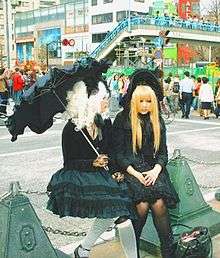Lolita fashion
Lolita (ロリータ・ファッション rorīta fasshon) is a fashion subculture originating in Japan that is based on Victorian and Edwardian clothing with a Rococo influence.[1]
Description
A 2008 New York Times report called lolita fashion a cross between Alice in Wonderland and the Addams Family, whose influences include "Victorian children’s wear, the French Rococo period, goth-inspired darkness and Japanese anime".[1]
History
The first known use of the term "lolita" as a Japanese subculture was in the September 1987 issue of Ryukou Tsushin, a Japanese fashion magazine.[2] However, the origin of the term's meaning is complex and remains unclear.[3]
The movement itself grew out of styles created by the Japanese brands Milk and Pink House, established respectively in 1970 and 1973. The styles were worn by the readers of Olive magazine, who were colloquially called "Olive girls".[2]
Designers branching out from Milk further influenced the style. In 1974, Rei Yanagikawa left Milk to start a children's clothing brand, Shirley Temple Cute, which would later expand to include a matching adult's otome fashion line under the name Emily Temple Cute. In 1985, Megumi Murano opened the otome fashion brand Jane Marple. In 1984, Atuski Onishi founded a self-named brand that also sold feminine, otome styled clothing. In 1988, one of Onishi's designers, Akinori Isobe, opened the Lolita fashion brand Baby the Stars Shine Bright.[2]
In the 1990s, brands such as Princess Princess grew more popular, influenced in part by the success of early visual kei bands throughout Japan. Some musicians, including Mana of Malice Mizer, founded lolita-inspired magazines,[4] which made the style popular among Japanese youth.
The fashion is being promoted throughout the world by the President of the Japan Lolita Association, Misako Aoki.[5]
Lolita styles
.jpg)
There are various of lolita styles, with indistinct boundaries between them. For example, a single lolita design could simultaneously reflect both sweet and classic styles.
- Sweet lolita[6] focuses on pastel or primary colors, and cute motifs.
- Classic lolita[6] focuses on muted or darker colors, antique motifs, and florals.
- Gothic lolita[6] focuses on black and dark colors, with gothic motifs.
References
- 1 2 Jimenez, Dabrali (26 September 2008). "A New Generation of Lolitas Makes a Fashion Statement". The New York Times. Retrieved 13 February 2010.
- 1 2 3 Kawamura, Yuniya (2012). Fashioning Japanese Subcultures. New York, NY: Bloomsbury Academic. p. 67. ISBN 978-1-84788-947-8.
- ↑ Hardy Bernal, Kathryn Adele. "The Lolita Complex: a Japanese fashion subculture and its paradoxes". Retrieved 26 April 2012.
- ↑ Ishikawa, Katsuhiko, Gothic & Lolita, Phaidon, 2007, p 1
- ↑ "Association formed to pitch ‘Lolita fashion’ to the world". Japan Times. 31 May 2013. Retrieved 15 June 2017.
- 1 2 3 "Coordinated Looks". Metamorphose. Metamorphose. Archived from the original on 5 March 2005.
External links
| Wikimedia Commons has media related to Lolita fashion. |
